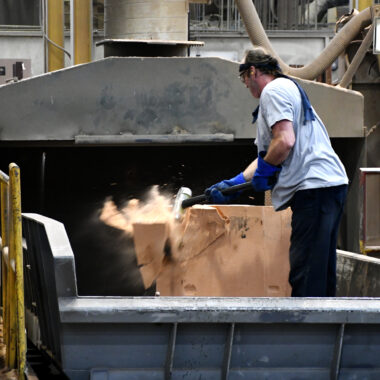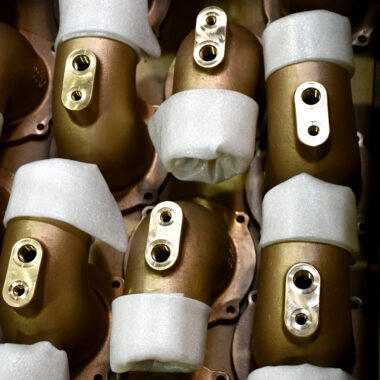Technology in Aluminum Casting: Cutting-Edge Techniques for Modern Designers
Aluminum casting, a standard production procedure, has seen an amazing makeover in recent times with the introduction of advanced methods that satisfy the needs of modern developers. From sophisticated 3D printing techniques that press the borders of layout to the integration of automation and robotics improving production, the landscape of aluminum casting is progressing quickly. Nonetheless, what absolutely establishes these innovations apart are the sustainable aluminum alloys being developed and the high-pressure die casting techniques that are revolutionizing the industry. Join us as we discover the center of light weight aluminum casting development, where innovation meets creativity to redefine what is feasible on the planet of steel casting.

Advanced 3D Printing Strategies
Utilizing advanced additive production procedures, advanced 3D printing techniques have reinvented the manufacturing of intricate and personalized light weight aluminum parts. By using high-precision printers that can deal with aluminum powders or filaments, producers can produce intricate geometries and layouts that were formerly unattainable via traditional manufacturing techniques.
One of the crucial benefits of innovative 3D printing in light weight aluminum part manufacturing is the capacity to attain light-weight yet sturdy frameworks. This is specifically beneficial in industries such as aerospace and automotive, where weight decrease is critical for improving fuel performance and total efficiency. Furthermore, the personalization choices provided by 3D printing enable the production of unique and tailored components that fulfill certain demands, resulting in improved functionality and efficiency.
In addition, the performance of the 3D printing procedure reduces material waste and reduces the total manufacturing time, making it an affordable service for manufacturing light weight aluminum elements. As technology remains to breakthrough, the abilities of 3D printing in aluminum manufacturing are expected to expand, offering also higher possibilities for innovation in numerous markets.
Computer-Aided Design Advancements
With the developments in innovative 3D printing methods for aluminum parts, the integration of Computer-Aided Layout (CAD) software application has actually ended up being increasingly essential in driving development and performance in the manufacturing procedure. CAD developments have actually transformed the means designers and designers create light weight aluminum spreading molds by supplying accurate electronic modeling capabilities. These software application devices enable the production of intricate styles and simulations that optimize the casting procedure, causing higher top quality components.
One of the crucial benefits of CAD in aluminum spreading is the capacity to spot prospective concerns early in the design phase, lowering costly errors and remodel throughout manufacturing. By mimicing the casting procedure basically, designers can evaluate aspects such as cooling down prices, material flow, and structural stability prior to a physical mold and mildew is developed. This proactive method not only conserves time and sources yet additionally ensures that the final aluminum components satisfy the preferred specs.
In addition, CAD software program makes it possible for fast iterations and modifications to designs, helping with rapid prototyping and personalization to satisfy particular needs. By leveraging CAD innovations in light weight aluminum spreading, suppliers can improve their procedures, boost item description high quality, and remain at the leading edge of development in the market.
High-Pressure Die Casting Methods
High-pressure die casting approaches are extensively identified for their effectiveness and precision in producing complex light weight aluminum parts. By making use of high pressure to force molten light weight aluminum right into elaborate molds at rapid rates, this method enables the creation of detailed and dimensionally exact parts. Among the essential advantages of high-pressure die spreading is its capability to produce get rid of slim walls and great information, making it excellent for applications where light-weight yet strong parts are needed.
The procedure begins with the prep work of the die, which is usually made from hardened device steel and is composed of two fifty percents that form the wanted part form. The liquified aluminum is after that injected into the die dental caries under high pressure, making certain that the material fills up all the detailed functions of the mold and mildew. Once the aluminum strengthens, the die opens, exposing the completed component ready for any type of essential post-processing.
High-pressure die casting is frequently used in various markets, consisting of automotive, aerospace, and electronics, where high-volume manufacturing of intricate aluminum elements is called for. casting aluminum illinois. Its capacity to deliver tight tolerances, superb surface area finishes, and affordable production makes it a recommended selection for modern developers aiming to introduce in light weight aluminum spreading strategies
Sustainable Aluminum Alloys Development

One approach to sustainable light weight aluminum alloy advancement involves incorporating recycled light weight aluminum material right into dig this the alloy structure. By making use of recycled aluminum, makers can reduce power intake and greenhouse gas emissions connected with primary aluminum manufacturing. Additionally, recycling light weight aluminum aids divert waste from garbage dumps, adding to a more circular economic situation.
Furthermore, researchers are discovering brand-new alloying elements and processing methods to boost the sustainability of aluminum alloys. By optimizing alloy structures and making procedures, it is possible to enhance the recyclability, sturdiness, and total ecological efficiency of aluminum products.

Automation and Robotics Integration
In the world of lasting aluminum alloys growth, the combination of automation and robotics is transforming manufacturing procedures, paving the means for boosted efficiency and accuracy in production. Automation and robotics are streamlining typical casting techniques, using various advantages to developers in the light weight aluminum market. By incorporating automation right into the casting procedure, repetitive jobs that were once labor-intensive can currently be efficiently managed by robotic systems, minimizing the risk of human mistake and increasing general performance.
Automated systems can work all the time, guaranteeing a continual production cycle that lessens downtime and takes full advantage of result. Robotics integration permits intricate styles and intricate molds to be generated with unrivaled precision, fulfilling the demands of contemporary designers for top quality aluminum parts. The use of automation in casting operations promotes a much safer working setting by minimizing the exposure of workers to dangerous conditions.
Final Thought
Advanced 3D printing methods, computer-aided style innovations, high-pressure die casting methods, sustainable aluminum alloys growth, and automation and robotics assimilation have all contributed to the modernization of the spreading procedure. The future of aluminum casting is intense with constant development and technological innovations.
What absolutely web sets these innovations apart are the lasting light weight aluminum alloys being developed and the high-pressure die spreading methods that are transforming the sector. Join us as we check out the forefront of light weight aluminum casting innovation, where modern technology satisfies creative thinking to redefine what is feasible in the world of steel casting.
One strategy to sustainable light weight aluminum alloy advancement entails integrating recycled aluminum material into the alloy structure - casting aluminum illinois. By utilizing recycled light weight aluminum, manufacturers can minimize energy usage and greenhouse gas emissions connected with primary aluminum manufacturing. Advanced 3D printing methods, computer-aided layout developments, high-pressure die spreading methods, sustainable light weight aluminum alloys development, and automation and robotics assimilation have all contributed to the modernization of the spreading process
Comments on “The Ultimate Source for Casting Aluminum Illinois”